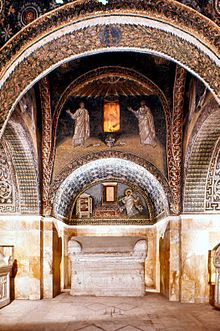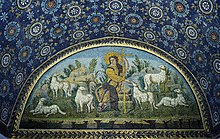Mausoleum of Galla Placidia
Raised by Serena, wife of Stilicho, she was made nobilissima in her youth and granted a palace by her father in Constantinople.
Her political influence waned with the growing maturity of her son and the rise to prominence of the patricius Flavius Aëtius in the 430s, but she remained powerful until she died in 450.
[6] She contributed to the refurbishment of Saint Paul's outside-the-walls (San Paolo fuori le Mura), as recorded in an inscription there.
[7] A basilica in Ravenna dedicated to Saint John the Evangelist (San Giovanni Evangelista) was also built by Galla Placidia after 425; it commemorated the augusta's and her children's deliverance from a threatening storm during a sea-voyage and was adorned with portraits of her and other members of the Theodosian dynasty.
[1] According to the mediaeval Liber Pontificalis Ecclesiae Ravennatis, an inscription on the apse of that basilica recorded the buildings status as an ex-voto in gratitude for Galla Placidia's survival at sea.
Mosaics composed of glass tesserae cover the interior walls of the vault, the lunettes and the cupola; the adornments are of high quality.
"[1] In the southern transept's lunette is a mosaic depicting a male saint carrying a cross accompanied by a burning gridiron and an opened cabinet containing the four canonical Gospels, identified by the names of the Four Evangelists in Latin.
[11] The figure of the Good Shepherd and pastoral scenes were familiar to Christian thought; depictions of a young man, the criophorus, bearing on his shoulders a sheep were known in the ancient world from the 6th century BC and was adopted from the late 3rd century AD into Christian art, especially in funerary contexts.
[13] The Lunette of Christ as Good Shepherd over the north entrance is representative of Christian art at this time period in late antiquity.
[citation needed] The forms still have three-dimensional bulk, but the shading such as in the folds of the robes is less refined than in the past, and figures are not very grounded.
The panel seems to be an illustration of the poem about St. Vincent in Prudentius's fifth century Passio Sancti Vincentii Martyris[citation needed].
[9] The mausoleum is reputed to have inspired American songwriter Cole Porter to compose "Night and Day" while on a 1920s visit.



